Vol 2 No. 35 TROPIC LIGHTNING NEWS September 4, 1967
Index
| Unit Page | Unit Page | Unit Page | Unit Page |
| 1st Bde 4 | 1/27 6 | 2/14 Photo 7 | 3/22 7 |
| 1st Bde Photos 4 | 1/27 6 | 25th Inf 1 | 4/23 7 |
| 1/5 Photo 1 | 2nd Bde 1 | 3/4 Cav 1 | 7/11 Arty 1 |
| 1/5 6 | 2nd Bde 6 | 3/22 6 | 86th Signal 3 |
| 1/5 Photo 6 | 2nd Bde 8 | 3/22 6 | 86th Signal Photo 3 |
| 1/5 8 | 2/14 7 | 3/22 7 |
OPN KILLS 452
By SSG Ray Levine
Viet Cong forces operating throughout Hau Nghia Province have been
dealt three major setbacks by elements of the 25th Inf Div during the first five
months of Operation "Kolekole," according to division officials.
VC Paid
The Viet Cong paid heavily in men - 452 killed in battle actions
and 464 more rallied under the Chieu Hoi program. It also cost them in the
destruction of tons of munitions and underground factories that were being used
to manufacture the munitions. Thirdly, they lost their hold - by terrorism
- over the people.
Never Recover
"We have crippled the Viet Cong so badly," says COL Edwin W.
Emerson, 2d Bde commander, "that I doubt whether they'll ever recover their
losses." Referring to the pacification program, he says, "We've
strengthened the bond between the Vietnamese poeple and the Allied forces, that
no amount of terrorism will break that bond."
Daily Assaults
Since the start of Kolekole, enemy base camps, fortifications,
supply routes and storage centers have been hit by daily helicopter combat
assaults, ground search and destroy operations, artillery and 840 tons of bombs
by air strikes.
Supply Point
Emerson commented on the recent destruction of the Viet Cong
munitions storage and manufacturing center along the Oriental River, 40 kms
northwest of Saigon. "Large enemy forces infiltrating from the west were
able to reach the river by traveling light and fast. The center provided
food, clothing, medical supplies, grenades, booby traps and mines. From
that point they would move out to their objectives."
Could Support 700
Early in the operation a base camp was uncovered not far from the
storage center, which officials felt could house a multi-battalion size enemy
force. LTC Chandler Goodnow, a battalion commander, estimated that, "The
camp could easily support 600 to 700 enemy soldiers, and serve as a staging area
for major guerrilla attacks in any part of the Hau Nghia-Saigon area."
The pacification program, according to Emerson, received top
priority because, "We had to increase the security for the people and at the
same time give them an economic boost."
Joint Operations
The security is being provided by joint brigade and ARVN
operations. The economic boost was supplied by the rebuilding of a
two-lane highway and two bridges to make the markets in Saigon, Duc Hoa and Bao
Trai readily accessible to farmers throughout the province.
MEDCAP
Civic action programs followed the brigade's combat elements
throughout the operation. Emerson cited as an example, "Over 15,000
Vietnamese patients were treated by MEDCAP personnel during those first five
months."
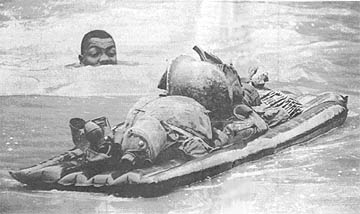 |
PUSHING his combat-laden air mattress, an infantryman swims across a monsoon flooded stream during a mission with the 1st Bn, 5th Inf. The battalion is participating in the 25thDiv's Operation "Kolekole" in Hau Nghia Province. (Photo by SP4 Dapprich) |
Gleason Is ADC
COL William T. Gleason has become a new assistant division
commander with the 25th Inf Div. He succeeds BG Robert C. Shaw, who has
been assigned to duty in India.
COL Gleason comes to the 25th from assignment as deputy assistant
chief of staff, J-4, Military Assistance Command, Vietnam (MACV).
A 1941 graduate of the U.S. Military Academy, he went on to
graduate from the Command and General Staff College, the Armed Forces Staff
College, and the Industrial College of the Armed Forces.
A veteran of World War II and the Korean War, the colonel has
received the Silver Star, Legion of Merit, and Bronze Star with oak leaf
cluster.
The colonel has been recommended for promotion to the rank of
brigadier general.
First Hip Shoot is on Target
Btry A, 7th Bn, 11th Arty, became the first in the 25th Inf Div to
execute a hip shoot - hasty occupation of position - when they answered a radio
call from the 3rd Sqdn, 4th Cav, for emergency fire support.
Receives Message
The battery was moving toward Cu Chi Base Camp on the road from
Sudi Cao when the request came in. After receiving the message, CPT
William Warnock, battery commander from Seymour, Conn., ordered the command
element to speed up through the village of X An Duc and seek a suitable place to
set up the unit's 105mm howitzers.
The mission of finding a good emplacement site was given to SFC
Tony Gonzales, Solana Beach, Calif., chief of firing battery. Meanwhile
Warnock located the battery and the target on the map.
Found Site
In a matter of minutes Gonzales found what he was looking for and
led the battery off the road and set up the howitzers. Firing charts were
set up by PFC William Randolph, battery chart operator from Ashville. N.C.
Working coolly and swiftly, he completed his task just three minutes after the
call was received. The accomplishment drew praise from SP5 John Briar of
Chicago, Ill., chief computer, as "the finest job I've seen yet."
Bore Sighted
While the firing data was being compiled by Briar and 1LT Gary
Pipkin, Boise, Idaho, the howitzers were bore sighted. This is not usually
done on a hip shoot but Pipkin recalls that "the commander thought they should
be bore sighted because of the heavy population in the area."
A perimeter was set up by SGT William Jones, the battery ammunition
sergeant from Lancaster, Pa., with organic weapons and two twin 40mm
"dusters" which were attached.
Duds
"We were in an open field," Jones recalls, "and the men were
finding dud grenades all over the place. Not knowing how long we were
going to stay in the position, and with no infantry to use on the perimeter, we
were concerned about a ground attack."
"When we heard that correction," relates SGT Allen Defies,
Chicago, Ill., acting chief of section of the gun that fired the shot, "we
knew we had fired a good first shot. It's hard to get that close to the
target on the first shot even when you are set up in camp and have all the
survey data."
The battery fired 63 high explosive rounds before "end of
mission" was given by the forward observer and the march to Cu Chi was
resumed.
High Morale
Speaking of the mission, Warnock recalls that "when we first got
there it was raining cats and dogs, we had no chow with us and I remember
Gonzales saying when the call first came down 'it can't be true.' There is
no question that the men's morale is high. After they found out what had
happened they reacted with speed and so little confusion that I was really
surprised.
The result of the action was given by the cavalry air observer as
"rounds on target."
Chaplain Visits 25th
The Reverend James D. Ford, Chaplain to the Corps of Cadets, U.S.
Military Academy at West Point, arrived at Camp Cu Chi Aug. 21 to begin a three
day visit.
Reverend Ford was here to observe the activities and
responsibilities of Military Academy graduates assigned to the 25th Inf Div.
Upon his arrival here he was met by Chaplain (LTC) John L. Barry,
division chaplain.
During his three-day visit Reverend Ford visited Div Arty, 125th
Sig Bn, Spt Cmd, 1st Bde, 65th Engr Bn, 3d Bde, 3d Sgdn, 4th Cav, 2d Bde, and
the 25th Avn Bn.
Page 2 TROPIC LIGHTNING NEWS September 4, 1967
Decorated
You cannot be saved by valor and devotion to
your ancestors. To each generation comes
its patriotic duty, and upon your willingness to sacrifice and endure, as those before you
have
sacrificed and
endured, rests the national hope.
Charles Evans Hughes
| BRONZE STAR (VALOR) | |
| CPT Allen A. Hinman, HHC, 1st Bn, 27th Inf | SGT George A. Holladay, Co A, 2d Bn (Mech), 22d Inf |
BRONZE STAR (MERIT) |
|
|
CPT Ernest W. Sanders, D Trp, 3d Sqdn, 4th Cav CPT Leonard G. Marcum, Co A, 1st Bn, 27th Inf SSG David A. Friedline, Co B, 1st Bn, 27th Inf SSG Jerry D. Mantooth, Co A, 1st Bn, 27th Inf SSG Devon T. Quirk, HHC, 4th Bn (Mech), 23d Inf SSG Charles I. Turner, Co C, 1st Bn, 27th Inf SSG Billy J. Anderson, HHC, 1st Bn (Mech), 5th Inf. SSG Roland N. Trudeau, Co C, 1st Bn, 27th Inf SSG Thomas A. Gonzalez-Rivera, Co C, 1st Bn, 27th Inf SGT Ivory Baker, HHC, 3d Bde SGT Gene A. Yohn, Co A, 1st Bn, 27th Inf SGT Reginald H. Duncan, Co C, 1st Bn (Mech), 5th Inf SGT Darrell J. Russell, Co C, 1st Bn (Mech), 5th Int SGT Franklin Short, Co A, 1st Bn (Mech), 5th Inf SP5 Juan Rangel, HHC SP5 Dennis Augustine, HHC, 3d Bde SP5 Clifford W. Silvia, HQ & Co A, 25th Med Bn SP4 Larry A. Grisci, Co B, 2d Bn (Mech), 22d Inf |
SP4 Andrew J. Short III, Co B, 2d Bn (Mech), 22d Inf SP4 Jerome G. McGovern, Co A, 1st Bn, 27th Inf SP4 Joseph White, Co C, 65th Engr Bn SP4 Clyde D. Shelton, HHC, 65th Engr Bn SP4 Clarence F. Gipson, Co A, 4th Bn, 9th Inf SP4 Alva N. Myrick, Co C, 1st Bn, 27th Inf SP4 John A. Sickles, Co C, 1st Bn, 27th Inf PFC Frank Jamison, Co A, 2d Bn, 14th Inf PFC James E. Coleman, Co A, 2d Bn, 14th Inf PFC Shelton Morgan, Co A, 2d Bn, 14th Inf PFC Ralph W. Crytzer, HHC, 1st Bn (Mech), 5th Inf PFC Antonio Flores Jr., Co B, 4th Bn (Mech), 23d Inf PFC Larry V. Sayers, Co A, 1st Bn, Bn, 27th Inf PFC Elbert T. Williams, Co C, 3d Bn, 22d Inf PFC Harold E. Southard, Co A, 1st Bn, 27th Inf PFC Daniel R. Hoffman, Co A, 1st Bn, 27th Inf PFC Albert Johnson, 38th Inf Pit (Scout Dog) |
ARMY COMMENDATION MEDAL (VALOR) |
|
| SGT William C. Sketo, Co A, 65th Engr Bn | |
ARMY COMMENDATION MEDAL (MERIT) |
|
|
SSG William Bodrick, B Btry, 2d Bn, 77th Arty SSG Billie D. Kliewer, Co E, 725th Maint Bn SSG Ronald D. Watkins, Co A, 25th S&T Bn SP5 Frank S. Walker III, 25th Admin SP5 Rocco T. Penna, Della, HHC, 4th Bn (Mech), 23d Inf SP5 Roy L. Roach, Co A, 65th Engr Bn SP5 Elvin B. Pedersen, 25th Admin Co SP4 Philip R. Brinegar, 25th Admin Co SP4 Lauren Daberkow, Co C, 4th Bn (Mech), 23d Inf SP4 Darrel Davis HHC, 25th S&T Bn SP4 Donley D. Granstra, Co C, 65th Engr Bn SP4 Glenn E. Hawkins, Co E, 65th Engr Bn SP4 John Hess, Co A, 125th Sig Bn SP4 Ralph E. Hoffman, 25th Admin Co SP4 William M. Strawn, Co A, 4th Bn (Mech), 23d Inf |
SP4 William P. Moyer Co E, 725th Maint Bn SP4 Reubin L. McClatchey, Co A, 4th Bn (Mech), 23d Inf SP4 Bobby W. Shettles, Co B, 2d Bn, 12th Inf SP4 Kenneth A. White, Co C, 4th Bn (Mech), 23d Inf SP4 Norman J.K. Waiholua, Co B, 2d Bn, 14th Inf SP4 Peter Klaus, 25th Admin Co SP4 Dan V. Briscoe, HQ & Co A, 725th Maint Bn SP4 Paul F. Koogler, HHC, 2d Bn, 14th Inf SP4 Walton R. Mathews, HHC, 1st Bn (Mech), 5th Inf SP4 Raymond D. Stroup, HHC, 4th Bn, 9th Inf SP4 Kerry W. Hensley, HHC, 1st Bn (Mech), 5th Inf SP4 Walter M. Swierski, HHC, 1st Bn, (Mech), 5th Inf SP4 Max E. Haeber, HHC & Band, 25th Inf Div Spt Comd SP4 George L. Bingel, Co B, 4th Bn, 9th Inf |
Emergency Leave Program Details, Steps Spelled Out
Every soldier has, at one time or another, heard of the Red Cross
Emergency Leave Program. But except for those who have actually been
through the process, the complete details and benefits are mostly unknown.
The following is a case history involving a 25th Inf Div soldier.
It illustrates in detail all the steps in obtaining, taking and returning from
emergency leave.
At midnight on July 15, a car carrying the parents of Private First
Class Mike O'Brien skids on a rain-swept highway in Arizona, and bangs into a
tree. Mike's father is unhurt, but his mother is critically injured and
is taken to the County Hospital.
The doctors inform Mike's father of the seriousness of the injury
and suggests that all immediate members of the family be notified.
Mike's dad tells the doctor that his son is in Vietnam. At 1 a.m. the
doctor notifies the local chapter of the Red Cross and verifies the seriousness
of the situation.
The local chapter representative obtains Mike's full name, rank,
service number, and unit designation, then relays the message via the teletype
to the American Red Cross National Headquarters in Washington, D.C. The
message is logged in, then turned over to the Armed Forces Communication Service
for overseas relay to Vietnam.
At 5 a.m., just four hours after the Red Cross is notified, the
message is received by wire at the 25th Div Communication Center, who in turn
deliver it to the Div Red Cross Field Office.
Usually the Red Cross field director delivers the message in
person, but Mike is in the field, so the message is transmitted to his Unit
Commander, who personally informs Mike of the Usually the Red Cross field
director delivers the message in person, but Mike is in the field, so the
message is transmitted to his Unit Commander, who personally informs Mike of the
accident, then arranges for immediate transportation back to base camp.
While Mike is making his way in from the field, the Red Cross
informs the division Adjutant General Personnel Action Branch, who after
verifying the fact that it is an immediate family member who is seriously
injured, cut travel orders for Mike.
As soon as they get the OK from AG, the Red Cross sends a message
back to the states, informing Mike's family that he is on the way.
Mike cleans up and packs, then reports to AG to receive 30 day
emergency leave orders. If he needs money, he draws a maximum partial pay
from finance and or an Emergency Leave Loan from the Red Cross. He then
goes to G-1 who have already arranged for helicopter transportation to Bien Hoa
and the 90th Repl Det there. At seven a.m. Mike is boarding the first
available plane for the states. He travels on a priority space-required
basis.
At 3 a.m. the following morning, Mike arrives at Travis AFB in
California. He checks in with the Army Transportation Coordinator in the
terminal, at which time his 30-day leave officially begins.
Mike is now on his own. He can try to get a military flight
to the AFB nearest his home town. If none are available, he can make
reserved-seat reservations on any commercial airlines at military rates (1/3 off
regular price).
There are no military flights available so Mikes uses the funds
from the Red Cross loan to purchase a commercial airlines ticket.
Mike arrives home two hours later, just 30 hours after the
accident. He stays home while his mother is recuperating, but just as his
leave is about over, she takes a turn for the worse. The doctor recommends
that Mike stay another week, and makes that request through the local Red Cross
chapter. Following the same procedure as the first message, the request
for leave extension is relayed to the 25th Inf Div AG. They approve
Mike's extension, and air-mail his new orders to him. During the next
few days Mike's mother improves a great deal, and the doctor says she'll be
OK. Mike now prepares to return to duty, but doesn't have enough money
for the plane fare to Travis.
He reports to the nearest military installation, and receives a
casual pay that allows him to buy the ticket.
The next day he reports to Travis, and his leave ends.
Because he is traveling TDY, he is booked on the next available flight to
Vietnam. A day later he arrives at Tan Son Nhut and reports to the 90th
Repl Det, who arrange military transportation for him back to his unit.
An hour later Mike returns to Cu Chi, and prepares to return to
duty.
This story is typical, and shows exactly how the Red Cross
Emergency Leave Program works. The emergency leave that Mike took DOES
count against regular leave time. However, if he had already used up his
leave, he could still go on emergency leave, but must either make up the days,
or if his ETS is too close, pay the Army for the month he took off.
Remember, before departing from your unit on
emergency leave, you MUST have the following items in your possession:
1. Authorized Emergency Leave Orders
2. Army Identification Card
3. Up-to-date Army Shot Record
4. DD Form 1580 (Authorization for Military Standby on Commercial
Airlines)
5. DA Form 2467 (Casual Pay Records)
If you have any questions concerning the Emergency Leave Program,
contact the 25th Inf Div Red Cross Field Office.
Overall Promotional Opportunities Has Best Outlook In DOD
History
Overall enlisted promotion opportunities today in the armed forces
are the best in the history of the Defense Department, Assistant Secretary of
Defense (Manpower) Thomas D. Morris testified Aug. 2 before the House Armed
Services Committee.
He said 970,300 promotions in grades E-4 through E-9 are projected
for FY68, with more than 85 per cent earmarked for E-4 and E-5 grades.
These hikes are slated, he said, within the all-service FY68 force structure of
1,760,000 non-commissioned officers and NCO-grade technicians.
Secretary Morris forecasts 568,800 promotions ranging from E-4 to
E-9 for the Army; 192,500 Navy, 149,900 Air Force and 59,100 Marine Corps.
The brightening EM promotion picture was only part of the
testimony, which covered the entire spectrum of enlisted promotion policies and
thinking. These equally important points were brought out:
* DOD believes it best for each service to determine its own annual
promotion requirements and capability.
* DOD plans, however, a future objective for each service to
forecast annually its own promotion picture for five years.
Army's rapid Vietnam buildup and draft dependence forces Army to
train and promote faster, particularly to E-4 and E-5.
| CODE
OF CONDUCT NO. IV When questioned, should I become a prisoner of war, I am bound to give only name, rank, service number, and date of birth. I will evade answering further questions to the utmost of my ability. I will make no oral or written statements disloyal to my country and its allies or harmful to their cause. |
The TROPIC LIGHTNING NEWS is an authorized publication of the 25th Infantry Division. It is published weekly for all division units in the Republic of Vietnam by the Information Office, 25th Infantry Division, APO San Francisco 96225. Army News Features, Army Photo Features, Armed Forces Press Service and Armed Forces News Bureau material are used. Views and opinions expressed are not necessarily those of the Department of the Army. Printed in Tokyo, Japan, by Pacific Stars and Stripes.
MG F.K. Mearns . . . . . . . . . . . . . . . Commanding General
Maj. Bernard S. Rhees . . . . . . . . . . . Information Officer
1Lt. Larry Rottmann . . . . . . . . . . . . . Officer-in-Charge
SSG David G. Wilkinson . . . . . . . . . Editor-in-Chief
SP5 Terry S. Richard . . . . . . . . . . . . Editorial Assistant
PFC Dave Cushman . . . . . . . . . . . . Editorial Assistant
Page 3 TROPIC LIGHTNING NEWS September 4, 1967
86th Sig Mans Cu Chi Commo
BY PFC Bill McCloskey
The primary mission of signal units attached directly to major
tactical forces in Vietnam is providing the commander in the field with direct
immediate communication with his superiors at Headquarters and subordinates at
their positions. Without this type of communications, the coordination
necessary to meet the lightning fast changes in conditions of this unique war
would not be possible.
To allow tactical signal units to devote their full efforts to this
most important assignment, units of the 1st Sig Bde (USA STRATCOM) are providing
base camp communications at many headquarters sites in Vietnam.
One of the largest such support operations is manned by the 86th
Sig. Bn., under the command of LTC Walter G. Ellis. His organization supplies
the administrative telephone hookups for the combat and support units stationed
at Cu Chi, home of the 25th Inf Div. In addition, smaller elements of his
command are deployed to Tay Ninh, Duc Hoa, and Dau Tieng with numerous platoons
and smaller detachments situated throughout the western section of the II Corps
area.
Each of these units has a mission requirement which makes it unique
in some way, but the massive base camp communications set up at Cu Chi give an
example of the importance and complexity of such operations.
The end product of this work by the Army's signalmen is the array
of signals which pour from the top of a 106 feet tall UHF/VHF tower located at
one edge of the 86th's real estate. All of the transmissions are line of
sight "shots" connecting the Cu Chi and Lightning switchboards with Saigon
and other major military installations within the south-central portion of
Vietnam. Including the systems operated by the 25th Div, there are a total
of 17 VHF/UHF systems, providing both voice and teletype trunking facilities,
which emanate from Cu Chi.
The addition of the 86th operated Cu Chi switchboard early in 1967
has also given the 25th and their Lightning switchboard direct entrance into the
long-distance worldwide communications network operated by 1st Sig Bde.
The importance of the 86th's contribution to the smooth running
of the 25th Div is outlined by 1LT Robert F. Berdan, of Fairfax, Minn., the 25th
Div wire officer. "The take-over of base camp communications by the Cu
Chi switchboard has allowed our own Lightning swithchboard to become even more
responsive to the division's tactical requirements," he says.
| View from the base of the 104 foot high UHF/VHF tower used by the 86th Sig Bn at Cu Chi shows the AN/TRC-24s, which look like bedsprings; and the new GRC-50 UHF Transmitter (cone-shaped) which were first used in Vietnam by the battalion. The new GRC-50s are a quieter system and avoid much of the vehicular radio noise sometimes picked up by other high frequency transmitters. (Photo by SP4 Robin Nolen) | 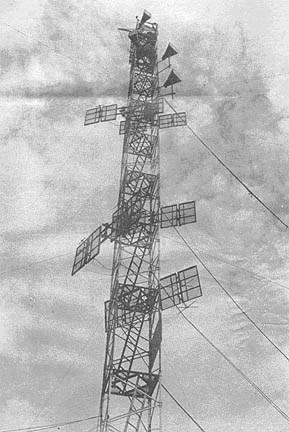 |
Before the 86th arrived, those signalmen who were not deployed to
the field with combat units were given the added responsibility of keeping the
huge population of the Cu Chi complex in communication with both distant points
and adjoining units. Under the current setup, signal units coming in from
the field from an operation can use time at base camp to conduct necessary
preventive maintenance and to clean their equipment so that they can be at
maximum efficiency at all times in the all important tactical situations.
Coordination of the administrative details of the hookups is
provided by the 25th in a cooperative effort which both groups say has worked to
the satisfaction of all concerned. Work orders for all new telephones on
the post are submitted to the Div Sig Officer LTC Louis G. Mathern Jr., and when
approved by him are forwarded to OTC Ellis for installation or other necessary
implementation.
The cut over from a tactical communications setup to a fixed plant
operation was accomplished on May 14, 1967. The 36 hour operation earned
for the 86th a letter of commendation from MG John C.F. Tillson III, then CG of
the 25th. He congratulated them for "their technical competency and
professional leadership." He further recognized "that careful planning
and long hours of work were expended to accomplish this task which is indicative
of the overall signal support rendered" by the 86th.
The 507 subscribers at Cu Chi are served with 40 long distance and
77 local trunks. A recent week saw 29,598 local calls placed on the
equipment and another 25,812 trunk calls.
Most calls to the switchboard are answered in one to four seconds
at the nine position MTC-9 switchboard. Supervising 30 operators, whom he
calls "the best in the country," is SSG McKinley R. Roberts of Alexandria,
Va. Local calls can be handled in less than five seconds from the sandbagged van
surrounded with Roberts' poppies and geranium plants.
The switchboard is manned 24 hours a day with a minimum of five men
overnight and as many as 11 during the peak hours.
At the Cu Chi wirehead, worked by other members of Co B, 3714 pairs
of wires are terminated. When fully utilized 4020 pairs may be handled.
Efforts to keep all of the battalion's lines in operation are
centered in Bn Control (BATCON), 1LT James C. Burdette of Sioux Falls, S. D.,
and SSG John H. Hopewell of Lorain, Ohio, explain that inside the two vans that
house the installation are several teletypes and telephones over which immediate
reports of circuit outages are transmitted. As soon as trouble is
reported, the 86th BATCON makes sure that repair teams have been dispatched and
then reports the trouble by teletype to the 2d Sig Gp Hqs at Long Binh, where
corrective action will be coordinated.
In addition to switchboard facilities and entrance into the long
distance worldwide communications network, the Cu Chi Base Camp operation of the
86th also provides over-the-counter services to the various support groups that
are located at Cu Chi. Pilots can learn what flying weather is throughout
the country via circuits provided by the 86th.
In addition, equipment operated by the 86th has the capability of
"going tactical" when the need arises. During Operation "Attleboro,"
circuits to Saigon were pre-empted to provide tactical units of the 25th
additional means of contact with Saigon. In Operation "Manhattan," the
86th was tasked with providing secure teletype circuits.
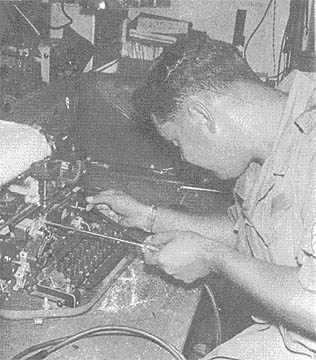 |
SSG Carlos Paz, NCOIC of B Co Personnel at the 86th Sig Bn's electronic maintenance section, fixes a TT-4 teletype. (Photo by SP4 Robin Nolen) |
| PFC Robert White of B Co, 86th Sig Bn, makes a cross-check in the stock files of the 587th Sig Co. Stocks from both companies are used to operate the 86th Sig Bn's electronic maintenance section. | 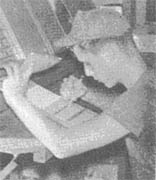 |
Page 4-5 TROPIC LIGHTNING NEWS September 4, 1967
By LT Marlow Haakenson
The 25th Inf Div's 1st Bde launched a six-week refresher training
schedule for the 1st, 7th Regt, 5th ARVN Div, on Aug. 15. An impressive
morning ceremony at Phu Hoa Dong signalled the start of the program.
BG Phan Quoc Thuam, commander of the 5th ARVN Div, and BG Donnelly
P. Bolton, assistant "Tropic Lightning" division commander, were both on
hand to kick off the first major program of this kind in the division.
The 1st Bde's Mobile Training Team (MTT), composed of two
officers and 16 non-commissioned officer instructors, set up a joint training
plan which emphasizes the techniques of leadership.
Also covered will be staff procedures, fire and maneuver, night
operations, extended field operations, airmobile operations and the use of
supporting fires. All units in the battalion will participate from the
squad to battalion level. A three-day Army Training Test (ATT) will top off the
training.
The combat-hardened ARVN's have worked with the 1st Bde in many
joint operations. However, a need exists for an exchange of ideas on
tactical principles and techniques, according to COL Robert Sonstelie, the
senior advisor with the 5th ARVN Div. Phu Hoa Dong, Hau Nghia Province, was
picked for the site of the initial program because it is the new home of the 1st
Bn, 7th ARVN Regt.
This battalion, commanded by Maj Pham Be, was a major maneuver
force in the recent pacification of Phu Hoa Dong one of the most important
pacification efforts conducted in III Corps zone.
On completion of the joint training, the ARVN regiment will remain
in Phu Hoa Dong to provide local security and to provide highly skilled maneuver
forces to the 1st Bde for the many "buddy" operations conducted in this
area.
COL Doniphan Carter, 1st Bde commander, is a firm believer in this
joint training venture. He said, "This training will be mutually
beneficial to the ARVN and American Soldiers. Each has something to pass
on to the other. We have conducted joint operations in the past, we know
each other's particular strengths, and we have developed a training program to
take advantage of that knowledge."
Carter went on to say, "I have selected officers and
noncommissioned officers to conduct this training who are experienced
instructors and who know and understand the ARVN soldier. I am confident
that the results will be of great benefit to all."
In the afternoon of the opening day, training was observed by GEN
Creighton Abrams, deputy MACV commander and MG F.K. Mearns, 25th Div CG.
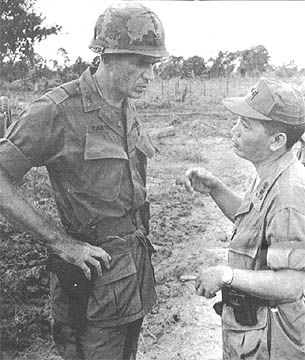 |
COL DONIPHAN CARTER AND COL VU CHONG DISCUSS THE ARVN TRAINING. (PHOTO BY DOUPE) |
| SFC LEON TETKOSKI TEACHES MAP READING TO A GROUP OF ARVNS. PRACTICAL EXERCISES ARE INCLUDED. (PHOTO BY DOUPE) | 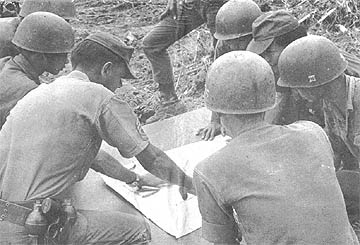 |
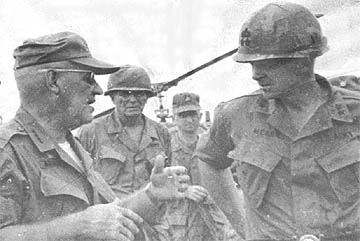 |
GEN CREIGHTON ABRAMS (LEFT), USARV DEPUTY COMMANDER, AND MG F.K. MEARNS, 25TH DIV CG, DISCUSS TRAINING. (PHOTO BY WERMINE) |
| INSTRUCTION ON .30 CAL. MACHINE GUN | 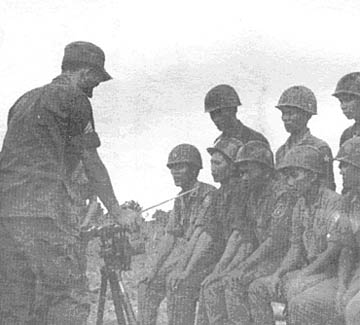 |
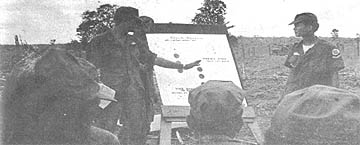 |
ENEMY FIRE DIRECTION DETERMINATION BY THE CLOCK METHOD IS TAUGHT TO ARVN TROOPS. AN INTERPRETER TRANSLATES THE LESSON. (PHOTO BY WERMINE) |
Page 6 TROPIC LIGHTNING NEWS September 4, 1967
Osaka Orphanage Receives VC Cash
A small Viet Cong force west of Saigon recently joined the 25th Inf
Div's "Wolfhounds" in supporting the Osaka Orphanage in southern Japan.
The contribution took place after a short but furious firefight
between the estimated squad and elements of the 1st Bn, 27th Inf. The U.S.
soldiers overran the enemy position after an aerial combat assault, killing
several VC guerrillas.
When intelligence officers examined papers found at the site they
discovered an enemy payroll containing a large roll of Vietnamese money.
After a few moments discussion, the "Tropic Lightning"
soldiers, who have supported the orphanage since the end of World War II,
decided to give the VC a chance to do their part.
SP4 Gets 12 Cong
DAU TIENG - SP4 Steve Hilton of High Point, N.C., who led his
marksmanship class in basic training, killed one and captured 11 other members
of a VC medical detachment in the jungles 12 kms south of Dau Tieng recently.
As the 3d Bn, 22d Inf, swept in by helicopter to surround the
village of Thanh An, Hilton and members of the Recon Plt took up blocking
positions in the rice paddies. On request of the helicopter gunships who
had checked the area for VC, two squads went into the jungle.
Hilton, on point, turned a corner in the trail to see several bags
resting at the base at a tree: then one VC popped his head out of a bunker.
Hilton snapped off a shot, killing him instantly. He fired twice more into
the entrance and then tossed in a grenade preparatory to making a search.
Eleven VC came out to surrender.
A quantity of medical supplies were seized in the bunker along with
an M-1 and a Russian AK-47 assault rifle.
The captured VC were part of the medical section of the 83d Rear
Support Group which supplies the enemy units in War Zone C.
New Exec At 2d Bde
LTC Fremont B. Hodson Jr. of Atlanta, Ga., recently became the new
executive officer of the 25th Inf Div's 2d Bde. He succeeds LTC Ted
Gordinier who was reassigned to division headquarters as assistant chief of
staff.
Hodson's last assignment prior to arrival in Vietnam was in the
Republic of China as secretary of the joint staff, MAAG.
He is a 1945 OCS graduate and served with the 7th Inf Div in Korea,
as a Reserve advisor in San Diego, and in Hqs 2d Inf Div.
He is a graduate of the University of Omaha, the Infantry Advanced
Course, the Armed Forces Staff College, and the Command and General Staff
College.
Hodson holds the Silver Star, the Legion of Merit, the Bronze Star
with "V" Device, and the Army Commendation Medal with two oak leaf clusters.
No. One
An armored personnel carrier driver from the 25th Inf Div's 1st
Bn (Mech), 5th Inf, was graduated Number One in the Div's Lightning Combat
Leaders Course. In the process he set the second highest overall score in
the history of the school.
SP4 Alan J. Mulree of Covina, Calif., scored 649 points out of a
possible 725 in the week-long course that emphasizes combat leadership skills
and thorough knowledge of individual weapons.
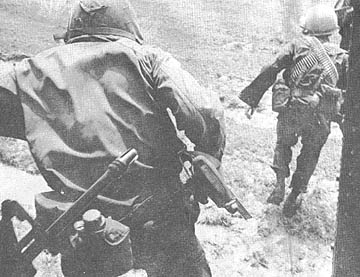 |
ASSAULT - Soldiers of the 1st Bn (Mech), 5th Inf, charge out of assault helicopters toward their objective during the 2d Bde Operation "Kolekole." (Photo by LT A.R. Karel) |
'Wolfhound' Gets Welcome From Orphanage Founder
A new "Wolfhound" soldier got a rousing welcome from an old one
recently in Hawaii when SSG Melvin Johnson of Lawton, Okla., met the founder of
the world famed Wolfhound Orphanage of Osaka, Japan.
Johnson flew to Hawaii on Rest and Recuperation from his duties
with the 1st Bn, 27th Inf, part of the 25th Inf Div.
"I visited the orphanage earlier this year," he said, "and I
thought Hugh O'Reilly would like to see the pictures we took."
O'Reilly founded the orphanage soon after World War II.
When the former master sergeant, now the vice-president of a large
Hawaiian bank, heard that a fellow Wolfhound from Vietnam was in Hawaii, he
registered him in one of Honolulu's best hotels and gave him a complete tour
of the city.
Johnson's wife arrived the next day and the couple joined
O'Reilly and his wife. "They wanted to hear all we could tell them
about the unit back in Cu Chi and the orphanage in Osaka," said Johnson.
"When we left he told us that he'd be very happy to meet any
other members of the 27th on R & R," the soldier said.
Since its beginning nearly twenty years ago, the orphanage had
grown to be considered one of the best in the Far East.
Missed?
DAU TIENG - In the recent helicopter assault on Thahn An Village,
12 kms south of Dau Tieng along the Saigon River, LT Donald Haas of the 3d Bn,
22d Inf, shot a VC, and nearly, as often happens, never knew it.
The 3d Bde, 25th Div, operation was designed to capture resident VC
in a cordon by the infantry units on three sides of the village while the fourth
side would be covered by "gunship helicopters.
Sweeping into the village Haas saw a VC streaking for a jungle
about fifty meters away. He raised his AR-15 and fired several shots
before the VC plunged into the trees, sure that he had missed.
The third platoon sergeant on a patrol later found the man's body
150 meters out on a trail.
Page 7 TROPIC LIGHTNING NEWS September 4, 1967
Combined Patrols Have Night Ambush Duty
Story and Photos
By SFC Roy Doupe
The early morning air still held some moisture from the previous
night's rain as the patrol moved out of Tan Phu Trung under a moonless sky.
The force, composed of troopers from the 2d Bn, 14th Inf, and Vietnamese
soldiers from Regional Force, Popular Force and Regular Army units, were going
out to set up a night ambush in the "Clover Leaf" area south of the 25th
Div's Cu Chi base camp.
The first few kilometers were easy going as they moved along
Highway 1 toward Saigon. However, this didn't last long as 1LT Charles E.
Chrosniak Jr., of Johnson City, Tenn., led the patrol off the highway and into
the extensive rice paddies that dominate the terrain in that area.
After two hours of wading through the paddies and trying to walk
along the dikes separating them, the patrol reached its ambush site and set up a
position designed to trap any Viet Cong that might move through that area.
Intelligence reports had indicated that not less than a VC squad was active in
the region.
Their vigil was fruitless though and at dawn the patrol left the
ambush to perform the second half of their mission, a sweep of the area north to
the village of Vinh Cu. Again, no contact was made with "Charlie"
although much evidence was found of his activities in the area.
During the sweep the Vietnamese and American troopers discovered
600 meters of tunnel complexes, blew up 52 tunnel entrances and destroyed two
bunkers and numerous booby traps. The discoveries exceeded all
expectations and the patrol had to be resupplied around noon with more
Composition-4, blasting caps and fragmentation and smoke grenades.
| BOOBY TRAP - One of the booby traps the patrol discovered as they swept an area near Cu Chi. | 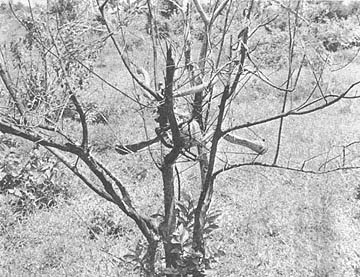 |
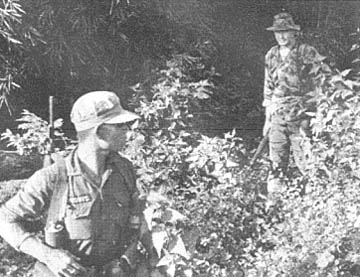 |
AREA SWEEP - An ARVN soldier and SP4 Dennis M. Swan of Miami Beach, Fla., a member of Co B, 2d Bn, 14th Inf, emerge from the jungle into an open area as the patrol sweeps the "Clover Leaf" area. 37 kms northwest of Saigon. |
Tax Collector Caught
DAU TIENG - The alertness of two soldiers of the 3d
Bde, 25th Inf
Div, netted a crafty VC tax collector recently during a lightning fast raid on
Thanh An Village, 12 kms south of Dau Tieng.
Sp4 James Hipps of Greenback, Tenn., and SP4 Mark Delong of Owen,
Wisc., felt left out as other members of the 3d Bn, 22d Inf, searched the
village. They were placed as guards at the edge of a rice paddy.
"Say, I think I see something," said Delong.
"It's a man all right," said Hipps, looking through a pair of
binoculars which brought the head and shoulders of a Vietnamese 400 meters away in the
rice paddies up close. As armed helicopters swept in over the paddies, the
man disappeared behind a dike, only to reappear again after a short interval.
Once the VC got up to shoo some dogs away.
The two guided a squad patrol out and found the man stretched out
beside a dike.
Mixed Nightly Patrols Provide BC Security
DAU TIENG - When the nightly ambush patrol leaves the 3d
Bn, 22d Inf, lines at Dau Tieng each evening, it's a mixed bag indeed - representative
of every contingent in the battalion. Along with the ubiquitous medic may
go a truck driver, a 4.2 mortar man, an operations clerk, a mechanic or radio
repairman, or any of the multiple trades which make the modern infantry
battalion function. It's a training mission for new replacements and the
last time out for the old.
While the main infantry elements are on missions far afield, the
ambush patrols carried on by these "instant" units are vital in the security
of the "Tropic Lightning's" third brigade base camp.
Miss Karen Breaks Jinx
"Everytime Miss Karen II gets hit I wonder if there is something
on her that could be making Charlie mad," stated SP4 Robert D. Chisholm of
Albuquerque, N.M., the driver of the company commander's track, 4th Bn (Mech),
23d Inf.
It seems that every time the CO's track goes on a mission it is
singled out from the rest and zeroed in on. Miss Karen I was stopped by a 105mm
artillery round that Charlie had fixed up as a mine when she had 495 miles on
the speedometer.
The following week Miss Karen II ran over a mine that had been
placed in the road but only the blasting cap went off, the rest of the mine did
not detonate. The mileage again was 495.
The next time the track was hit was on a search and destroy mission
in the Boi Loi Woods. Five tracks had gone past when "BANG," Miss
Karen II was blasted by a claymore mine and grenades and she went back to the
shop for repairs.
Page 8 TROPIC LIGHTNING NEWS September 4, 1967
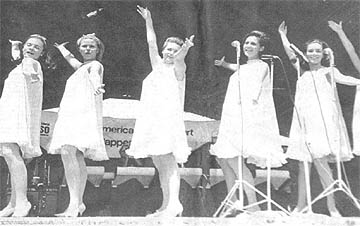 |
| Miss America and her court entertain 4500 soldiers at the 25th Inf Div's Lightning Bowl in Cu Chi. The show, "What's Happening Back Home," features (left to right) Miss Maine 1964-Ellen Warren; Miss South Carolina 1966-Barbara Harris; Miss America of 1967-Jane Jayroe; Miss Alabama 1966-Angeline Grooms; Miss Connecticut 1966-Carol Gelish; and Miss Wisconsin of 1965-Mary Singstock. (Photo by PFC Pullen) |
Loud Pants Big Hit
When civil affairs soldiers of the 25th Inf Div's 2d Bde recently
began distributing colorful shorts to the children of Hau Nghia Province they
nearly turned one small hamlet into a nudist colony.
CPT Albert Amos of Mobile, Ala., tells how the first thing he
noticed in Vietnam was how many little kids run around without clothes.
Amos sent back to the states for hundreds of brightly colored
shorts.
Problems arose almost immediately. "We couldn't figure
out how to distribute them," he said, "so we just walked down the street in
Loc Thanh, a nearby hamlet, and started putting shorts on every bare kid we
spotted. They made a big hit and we ran out in minutes."
Returning the next morning with what he figured was enough for a
full day, he and his two assistants were swamped with clothesless children.
"As soon as they saw us coming," he said, "they ran behind a building or a
bush, pulled off all their clothes, and ran back for shorts."
The day's supply ran out in the first hour and the three
bewildered soldiers returned to their base camp exhausted. "I'm still
sure it was basically a good idea," says Amos, "we'll just have to
approach it a little differently next time."
Couldn't Move
Thanks to
Gary Hartt, 2nd Bn., 22nd Inf. for sharing this issue,
Kirk Ramsey, 2nd Bn., 14th Inf. for creating this page.
This page last modified 8-12-2004
©2004 25th Infantry Division Association. All rights reserved.